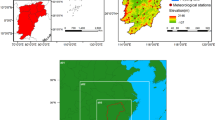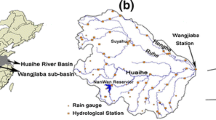Abstract
An accurate flood forecasting with long lead time can be of great value for flood prevention and utilization. This paper develops a one-way coupled hydro-meteorological modeling system consisting of the mesoscale numerical weather model Weather Research and Forecasting (WRF) model and the Chinese Xinanjiang hydrological model to extend flood forecasting lead time in the Jinshajiang River Basin, which is the largest hydropower base in China. Focusing on four typical precipitation events includes: first, the combinations and mode structures of parameterization schemes of WRF suitable for simulating precipitation in the Jinshajiang River Basin were investigated. Then, the Xinanjiang model was established after calibration and validation to make up the hydro-meteorological system. It was found that the selection of the cloud microphysics scheme and boundary layer scheme has a great impact on precipitation simulation, and only a proper combination of the two schemes could yield accurate simulation effects in the Jinshajiang River Basin and the hydro-meteorological system can provide instructive flood forecasts with long lead time. On the whole, the one-way coupled hydro-meteorological model could be used for precipitation simulation and flood prediction in the Jinshajiang River Basin because of its relatively high precision and long lead time.





Similar content being viewed by others
References
Deb SK, Srivastava TP, Kishtawal CM (2008) The WRF model performance for the simulation of heavy precipitating events over Ahmadabad during August 2006. J Earth Syst Sci 117(5):589–602
Duan Q, Sorooshian S, Gupta VK (1994) Optimal use of the SCE-UA global optimization method for calibrating watershed models. J Hydrol 158(3):265–284
Gilliam RC, Pleim JE (2010) Performance assessment of new land surface and planetary boundary layer physics in the WRF-ARW. J Appl Meteorol Clim 49(4):760–774
He M, Zheng H, Huang X, Jia J, Li L (2013) Yangtze River sediments from source to sink traced with clay mineralogy. J Asian Earth Sci 69:60–69
Hong S, Dudhia J, Chen S (2004) A revised approach to ice microphysical processes for the bulk parameterization of clouds and precipitation. Mon Weather Rev 132(1):103–120
Jankov I, Gallus WA Jr, Segal M, Shaw B, Koch SE (2005) The impact of different WRF model physical parameterizations and their interactions on warm season MCS rainfall. Weather Forecast 20(6):1048–1060
Kain JS, Fritsch JM (1993) Convective parameterization for mesoscale models: The Kain–Fritsch scheme. The representation of cumulus convection in numerical models. Springer, New York, pp 165–170 (reprinted)
Kang T, Lee S (2014) Modification of the SCE-UA to include constraints by embedding an adaptive penalty function and application: application approach. Water Resour Manag 28(8):2145–2159
Raju P, Potty J, Mohanty UC (2011) Sensitivity of physical parameterizations on prediction of tropical cyclone Nargis over the Bay of Bengal using WRF model. Meteorol Atmos Phys 113(3–4):125–137
Skamarock WC, Klemp JB, Dudhia J, Gill DO, Barker DM, Wang W, Powers JG (2005) A Description of the Advanced Research WRF Version 2. Report No. NCAR/TN 468+STR
Srivastava PK, Islam T, Gupta M, Petropoulos G, Dai Q (2015) WRF dynamical downscaling and bias correction schemes for NCEP estimated hydro-meteorological variables. Water Resour Manag 29(7):2267–2284
Wu W, Xu S, Lu H, Yang J, Yin H, Liu W (2011) Mineralogy, major and trace element geochemistry of riverbed sediments in the headwaters of the Yangtze, Tongtian River and Jinsha River. J Asian Earth Sci 40(2):611–621
Yuan X, Liang X, Wood EF (2012) WRF ensemble downscaling seasonal forecasts of China winter precipitation during 1982–2008. Clim Dynam 39(7–8):2041–2058
Zeng X, Wu Z, Xiong S, Song S, Zheng Y, Liu H (2011) Sensitivity of simulated short-range high-temperature weather to land surface schemes by WRF. Sci Chin Earth Sci 54(4):581–590
Zhang J et al (2007) Study of runoff of the six large basins in China over the past 50 years. Adv Water Sci 2:230–234 (in Chinese)
Acknowledgements
This work is supported by the Key Program of the Major Research Plan of the National Natural Science Foundation of China (No. 91547208), the National Natural Science Foundation of China (No. 51579107), and the National Key R&D Program of China (2016YFC0402205 and 2016YFC0402209).
Author information
Authors and Affiliations
Corresponding author
Additional information
Responsible Editor: M. Kaplan.
Rights and permissions
About this article
Cite this article
Zhou, J., Zhang, H., Zhang, J. et al. WRF model for precipitation simulation and its application in real-time flood forecasting in the Jinshajiang River Basin, China. Meteorol Atmos Phys 130, 635–647 (2018). https://doi.org/10.1007/s00703-017-0542-9
Received:
Accepted:
Published:
Issue Date:
DOI: https://doi.org/10.1007/s00703-017-0542-9




